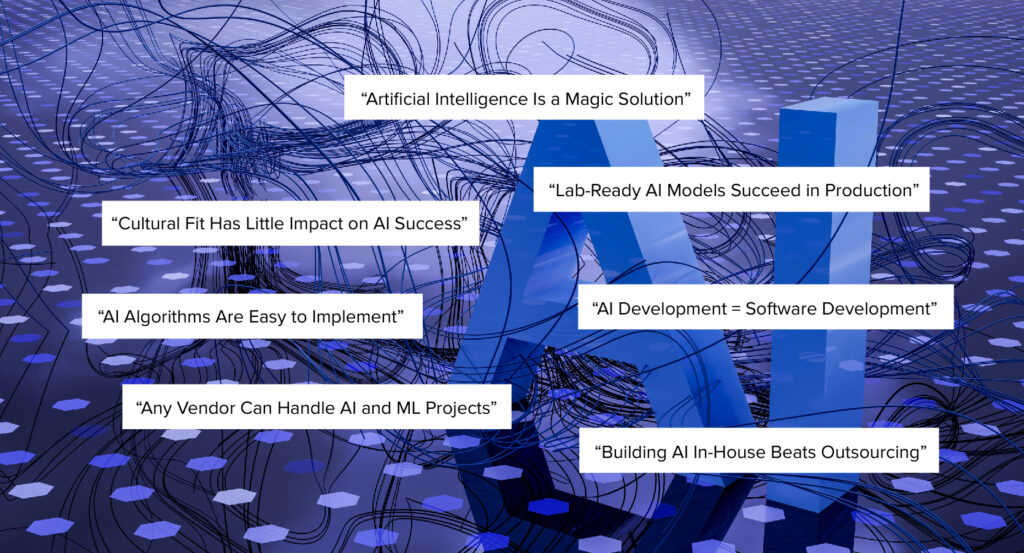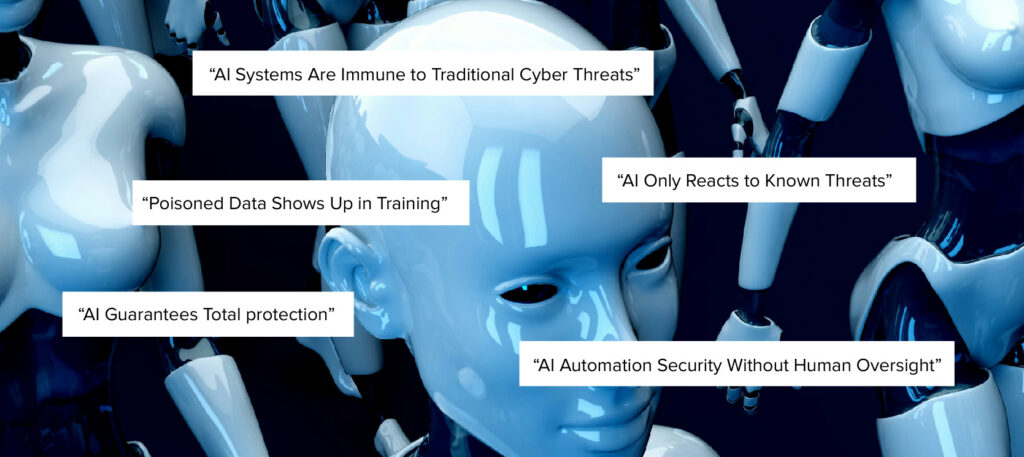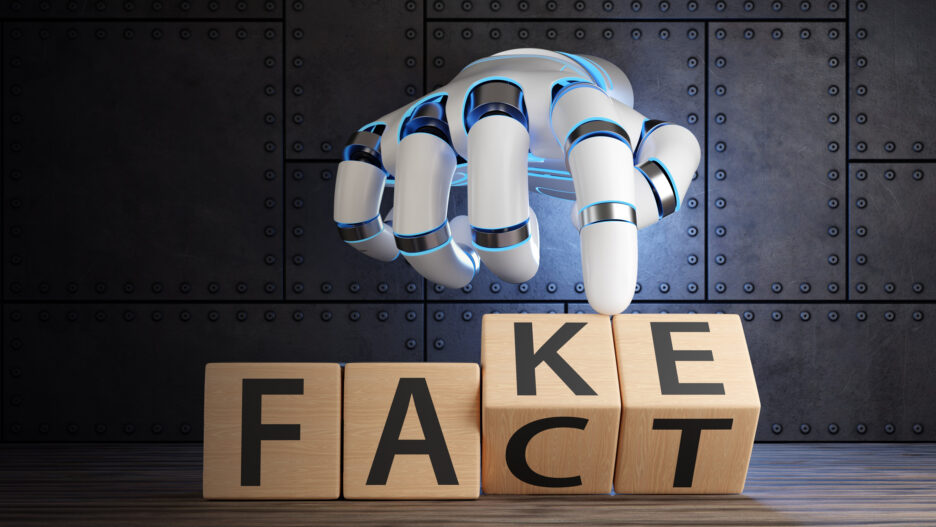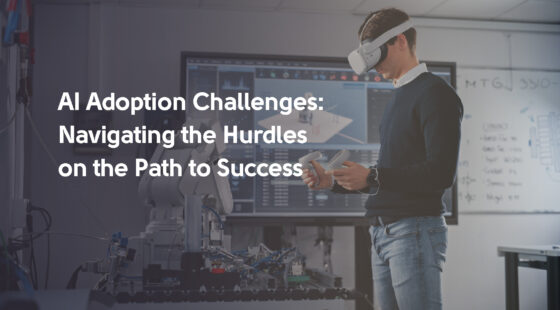Although myths began in Ancient Greece and had no basis in reality, modern myths about technological progress are widely believed, and artificial intelligence or machine learning are no exceptions. A lot of people are confident that AI is a magic pill for all the business’s issues, resistant to any traditional cyber threat, or that general software development experience guarantees success in AI project management.
In this article, we’ll help you see the full picture clearly and debunk each of the false yet common AI myths. It’s time to start your eye-opening journey into the real world of artificial intelligence.
General Myths About AI and ML

Let’s evaluate how well you understand the true capabilities of artificial intelligence that simplify your day-to-day business processes.
AI Myth #1: Artificial Intelligence Is a Magic Solution that Instantly Solves All Business Problems
We all tend to believe that a new technology will eventually solve all our business problems, ideally with minimal supervision. That’s why, as soon as AI appeared, many of us eagerly believed this dream was coming to life.
| Myth Supporting Arguments | Reality |
| - Automation boosts efficiency – AI can handle forecasting, content creation, and other repetitive tasks. - Impressive domain performance – In some fields, simple AI techniques can match or surpass human performance (e.g., certain medical models). | - Data quality dependency – “Garbage in, garbage out.” - Explainability issues – Complex models can be opaque, limiting trust in critical sectors. - Lack of common sense – AI struggles with nuance, context, and open-ended reasoning. - Inconsistent performance – Even advanced AI makes avoidable mistakes. - Human skills remain vital – Analytical thinking, creativity, ethics, and systems design are irreplaceable. - Ethical & legal challenges – AI faces regulatory, security, and moral constraints. - Need for human oversight – AI requires human monitoring, validation, and intervention. |
AI Myth #2: AI Algorithms Are Straightforward and Easy to Implement
Yes, some time ago, AI was only accessible to highly skilled developers. As time passes, AI solutions are becoming increasingly user-friendly. There are now low-code/no-code options that allow users with limited coding knowledge to benefit from artificial intelligence. However, this doesn’t mean that AI algorithms are simple or that anyone can implement them easily.
| Myth Supporting Arguments | Reality |
| - Some simple algorithms are accessible — Basic classifiers like decision trees or k‑nearest neighbors are beginner-friendly and supported by frameworks like scikit‑learn, TensorFlow, or PyTorch. - Open-source tools help lower barriers — Libraries and pre-built models (e.g. via PyTorch, Hugging Face) democratize access and reduce initial implementation effort. | - Complexity ramps up quickly — Real-world AI often involves deep learning, multi-layered models, and ensemble systems, which are far from simple. - Infrastructure and scalability aren’t trivial — Transitioning from prototype to production requires robust infrastructure, cloud or distributed systems, and careful scaling. - Expertise shortage is a barrier — Skilled experts like data scientists and ML engineers are essential. Many organizations struggle to recruit or develop this talent. - Integration with legacy systems is complex — AI tools often don't fit into existing workflows or systems, requiring middleware, APIs, or even process redesign. - Operational challenges abound — Monitoring, model drift, maintenance, and governance are often overlooked, but essential for long-term performance. |
| Interesting term: Moravec's paradox is the idea that tasks easy for humans (walking, seeing) are hard for AI, while tasks hard for humans (math, chess) are easier for AI. Human brains evolved for physical tasks, but AI excels at logical ones. |
AI Myth #3: Cultural Fit Has Little Impact on AI Project Success
The significance of aligning with the organization’s internal culture is often overlooked or even ignored completely. And this is a considerable mistake.
| Myth Supporting Arguments | Reality |
| - Certain AI tools are intuitive and reusable — Pre-built AI agents or standard solutions often come with familiar interfaces or are plug‑and‑play, reducing the need for deep cultural customization. (though real evidence is limited.) | - Culture shapes AI readiness and adoption — Resistance to change, fear of failure, and poor data literacy slow uptake. Successful organizations foster curiosity and learning cultures to support AI integration. - Trust and transparency are essential — Without a culture that frames AI as augmenting rather than replacing roles, employees will resist. - Leadership and training are key — Companies that launch AI training, pilot small wins, and reframe leadership messages realize adoption gains of up to 65% and productivity lifts of about 30%. - Human skills remain central — Analytical reasoning, responsible judgment, communication, and creativity are critical. Companies that invest in soft skills nearly double their odds of successful AI adoption. - Employee morale and satisfaction matter — Involving staff reduces AI resistance. And prevents skill loss |
AI Myth#4: Any Vendor with General Software Development Experience Can Handle AI and ML Projects
It is believed that general software development skills are sufficient to handle AI/ML projects of any size. While this may be true for some specific projects, it wouldn’t be wise to assume this statement applies universally to all scenarios.
| Myth Supporting Arguments | Reality |
| - General devs can build AI wrappers or call APIs — With platforms like OpenAI or Google Vertex AI, even developers without ML training can integrate pre-trained models for basic tasks like classification or summarization. - Low-code tools simplify some tasks – Platforms like DataRobot let non-experts build basic models. | - AI has a unique lifecycle – ML needs data prep, training, tuning, and monitoring, which is outside general dev skills. - High failure rates – 85% of AI projects fail, often due to a lack of AI-specific expertise. - Data quality is critical – AI depends more on data than code. Most devs lack data engineering experience. - Debugging AI ≠ debugging code – General devs often don’t understand how to tune or troubleshoot ML models. - AI needs collaboration – AI/ML success depends on teamwork across roles: data scientists, engineers, and domain experts. |
AI Myth #5: AI/ML Models that Perform Well in the Lab Will Succeed in Production
It might seem naive, but many people still believe lab results guarantee a machine learning model’s success. Although this idea has some truth, it’s not entirely accurate.
| Myth Supporting Arguments | Reality |
| - Lab success shows potential — Strong lab results indicate a model can learn patterns and may serve as proof of concept. - Validation can catch issues — Techniques like cross-validation help reduce overfitting. | - Data & concept drift degrade accuracy — Models trained on static data often fail when production data evolves. - Lab metrics ≠ live metrics —Offline metrics don’t always align with live performance; gaps arise without A/B or canary testing. - Integration and infrastructure challenges — Deploying models requires handling containerization, scalability, latency, and mismatched environments, which are not addressed in lab experiments. - No monitoring = silent failures — Many models lack monitoring for drift, errors, or outages, causing unattended performance decay. - Data leakage inflates results — Hidden leaks can falsely boost lab performance. |
| Interesting fact Sometimes AI hallucinates. It happens when generative models confidently produce false or misleading information, such as made-up facts, unreliable sources, or entirely fabricated content. Key reasons for AI hallucination: - AI may produce plausible answers that aren't verified facts - Missing or biased training data results in incorrect details - Models lack live validation against trustworthy sources. |
AI Myth #6: AI Development Follows the Same Process as Traditional Software Development
Software development can vary. Although AI is also seen as software, the main difference is that it usually involves algorithms that can learn and adapt from data instead of being explicitly programmed for each task.
| Myth Supporting Arguments | Reality |
| - Both involve deployment & integration — AI systems still need standard steps like deployment, version control, and system integration. - Both require testing — You still need to validate correctness, performance, and reliability. | - AI/ML projects are probabilistic — they don't guarantee the necessary precision, accuracy, or recall for business problems. Traditional software development is deterministic and reliably delivers a webpage, database, etc. - AI is data-driven — AI projects require continuous data collection, cleaning, model training, validation, and retraining, not a linear code‑build cycle. - AI Software Development Life Cycle (SDLC) is experimental — Conventional projects follow a waterfall model; AI development is agile, experimental, and depends on results from data. - MLOps is essential — AI needs model tracking, monitoring, retraining, data, and model versioning, which isn’t typical in traditional dev workflows. - Ethics and bias matter —AI development requires attention to fairness, explainability, and legal compliance. - More team roles involved — AI needs close work between devs, data scientists, and domain experts. |
AI Myth#7: In-house AI Development Is Always More Cost-Effective than Outsourcing
“The smaller the initial expenses, the higher the ROI” is one of the biggest misconceptions in any business project, and AI development is no exception. External expertise providers, such as Svitla Systems, bring specialized, high-quality skills to your in-house team without the need for hiring and training new full-time employees.
| Myth Supporting Arguments | Reality |
| - Full control & IP — In‑house gives you complete customization, data security, and IP ownership. | - High initial investment – Building in-house requires costly infrastructure, tools, and specialized talent. - Talent scarcity – Hiring and retaining skilled AI engineers is expensive and competitive. - Slower time-to-market – Internal teams may take longer to deliver results compared to experienced external providers. - Hidden maintenance costs – Ongoing updates, bug fixes, and model retraining add long-term expenses. - Limited specialized expertise – Outsourcing can provide niche knowledge and advanced capabilities that in-house teams may lack. |
Myths about AI and Cybersecurity

Since AI’s functioning mainly relies on data, it’s important to regulate what information it can access to prevent data leaks, especially concerning personal or other sensitive information. This led to a number of AI myths about cybersecurity.
Myth About AI and Cybersecurity #1: AI Systems Are Inherently Secure and Immune to Traditional Cyber Threats
This myth likely stems from the fact that AI includes the word “intelligence,” leading people to believe it can quickly and effectively identify any cyberthreat. Unfortunately, this is far from the truth.
| Myth Supporting Arguments | Reality |
| - Self-learning resilience – AI adapts over time and can automatically counter new threats. - Automated anomaly detection – AI can detect threats faster than humans. | - AI can be hacked – Adversarial attacks can manipulate inputs (e.g., image recognition errors in self-driving cars). - Vulnerable to data poisoning – Malicious manipulation of training datasets can control model behavior. - Model inversion threats – Hackers can extract sensitive data from AI models. - Over-reliance blind spots – AI may ignore novel or stealthy threats not represented in training data. - Human oversight remains essential – Security frameworks (e.g., ENISA) stress human-in-the-loop, standards, and multi-layer defence. |
Myth About AI and Cybersecurity #2: Data Poisoning Attacks Are Easily Detectable During Model Training
This misconception is linked to the myth about lab results and their potential success in production. However, not everything can be tested, and when it comes to cybersecurity, the stakes for such risks become too high.
| Myth Supporting Arguments | Reality |
| - Standard validation catches anomalies – Belief that cross-validation or holdout splits will flag poisoned data early in training. - Simple audits detect tampering – Thought that quick data reviews or audits will spot malicious alterations. | - Poisoning often evades basic detection – Poison blends with clean data, bypassing standard checks. - Backdoors hide well – Hidden triggers in poisoned data don't affect normal task performance, which makes backdoors hard to detect. - Proactive defence is costly or limited – effective methods need heavy computation or lack strong detection guarantees. - Deep learning amplifies undetectability – Complex deep learning pipelines mask poisoning. - Detection needs specialized methods – Only specific tools like cryptographic provenance, data sanitization, or anomaly-robust models offer some resistance. |
Myth About AI and Cybersecurity #3: AI Only Reacts to Known Threats
AI’s capabilities are rapidly advancing, especially in cybersecurity. Though AI can’t provide a 100% protection guarantee, its ability to analyze and learn enables artificial intelligence to predict potential upcoming attacks.
| Myth Supporting Arguments | Reality |
| - Signature-based limits – Assumes AI relies on static malware patterns and cannot detect new threats. - Reactive automation only – Belief that AI merely automates responses but doesn’t foresee threats. | - Detects anomalies and zero-days – AI identifies unusual behavior and patterns to catch threats without prior signatures. - Predictive threat forecasting – AI analyzes past incidents and threat data to anticipate future attacks. - Continuous learning adapts – AI models update with new data to improve detection over time. - Behavior-based detection – AI spots insider threats and stealth attacks via behavioral analytics. - Proactive hunting and automation – AI enables threat hunting and auto-response, reducing reliance on human-only detection. |
Myth About AI and Cybersecurity #4: AI Guarantees Complete Protection Against All Threats
The idea that AI is all-powerful is false at its core, but even if it were true, doesn’t it make sense that hackers can also use AI in their cyberattacks?
| Myth Supporting Arguments | Reality |
| - AI auto-detects everything – Assumes AI can catch all attacks in real time. - AI replaces human security – Belief that AI removes the need for human oversight. | - AI misses novel threats – Adaptive attacks can bypass detection. - Attackers use AI too – Criminals deploy AI for phishing, exploits, and reconnaissance. - AI adds new vulnerabilities – Prompt injection, model drift, and insecure guardrails are exploitable. - Blind spots persist – AI lacks human intuition and contextual reasoning. - Human-AI partnership is essential – Combining AI speed with human expertise builds real resilience. |
Myth About AI and Cybersecurity #5: AI Fully Automates Security Processes, Eliminating Human Oversight
Just like with any other AI-based process, cybersecurity procedures need human oversight at certain points. And here’s why.
| Myth Supporting Arguments | Reality |
| - AI covers everything – Belief that AI handles detection, response, and decision-making end-to-end. - Automation removes bias – Assumes AI is neutral and, therefore, fully trustworthy. | - Human review remains mandatory – Humans verify AI triage before high-impact actions. AI assists with tier-1 tasks, while humans maintain control over critical decisions. - Opaque AI requires oversight – AI decisions can be “black-box”, which makes human interpretability and accountability essential. - Threats evolve faster than automation – AI needs human analysts to deal with novel attack methods and unpredictable contexts. - Human-AI collaboration boosts effectiveness – Security incidents require judgment, context, and ethical evaluation that AI alone can’t provide. - Hybrid autonomy models are emerging – Tiered frameworks help calibrate AI autonomy with human-in-the-loop design, especially in security operations centers (SOCs). |
Summing Up
Since AI has been one of the most popular topics for several years and is unlikely to lose its significance, it's important to learn how to tell facts from AI myths. More and more new functions and capabilities are emerging, and versions are upgraded almost every day; however, artificial intelligence is not all-powerful, so you can’t rely on it blindly, as it can be quite risky in terms of compliance, cybersecurity, and more. To reduce these risks, address the Svitla team of AI and machine learning experts to get the most out of modern technologies safely.




![[Blog cover] Agentic AI vs traditonal automation](https://svitla.com/wp-content/uploads/2025/09/Blog-cover-Agentic-AI-vs-traditonal-automation-560x310.jpg)
